Of all the @Play columns, which begin to approach 100 in number, I have only directly tackled Angband once. I admit, that’s a huge oversight. Our first treatment of Angband was on GameSetWatch, which now only exists on the Wayback Machine. A reprint of that column is in my @Play collection Exploring Roguelike Games, out in print through CRC Press, but that’s admittedly kind of expensive.
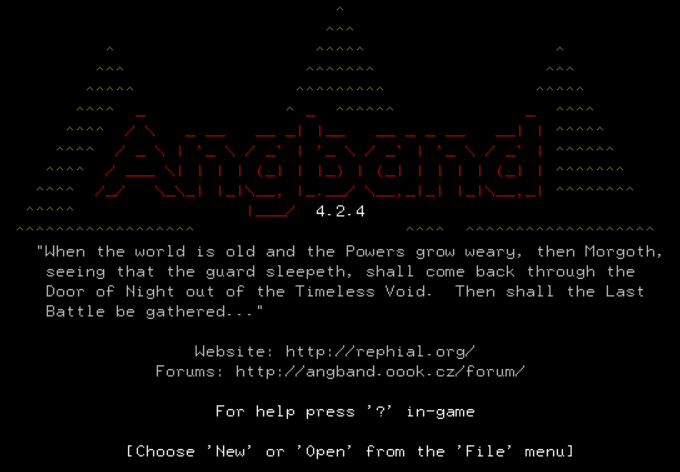
An Angle on Angband
If you’ve played a Hack-like, Angband (home page) will probably look fairly similar at first. It, too, is a grid-based dungeon exploration game where you fight lots of monsters and find objects with unknown properties that you must discover as you play. Both games have randomized maps, dangerous monsters with fearsome abilities, powerful magic items to use against them, spells you can learn and cast, and traps you must look out for. Both standard-bearer for the Hack series, NetHack, and Angband now feature graphical tiles by default, although they can also be played in the old ASCII-based format.
Where the games differ is in their general philosophy of what dungeon exploration means. While NetHack has lots of strong monsters, it seems to take the view that the dungeon itself is your greatest opponent. The puzzle of figuring out item identities is a larger part of the game, and NetHack offers both more uncertainty in identification and more ways to identify. NetHack has more set locations that offer specific puzzles players must overcome, like finding the Luckstone at the bottom of the Gnomish Mines, or getting past Medusa, or crossing the moat around the Castle; Angband has only one set location, its Town, although there are lots of special areas that can be randomly found within its dungeon levels.
NetHack’s dungeon cannot be exited without giving up the game, for even once you get the Amulet and escape, you’re thrown into an End Game that functions as a coda to your adventure; in Angband, you’ll probably leave the dungeon many times in order to avail yourself of the Town’s useful services. In Angband, this Town offers shops where you can buy and identify items, but the shops are all menus. NetHack’s shops have a physicality, in that they’re rooms in the dungeons, overseen by a Shopkeeper character, which allows players to steal from shops if they can survive the shopkeeper’s eyes and wrath. And, of course, NetHack has its iconic pets that can help you explore the dungeon and provide other services, while in Angband you fight alone.
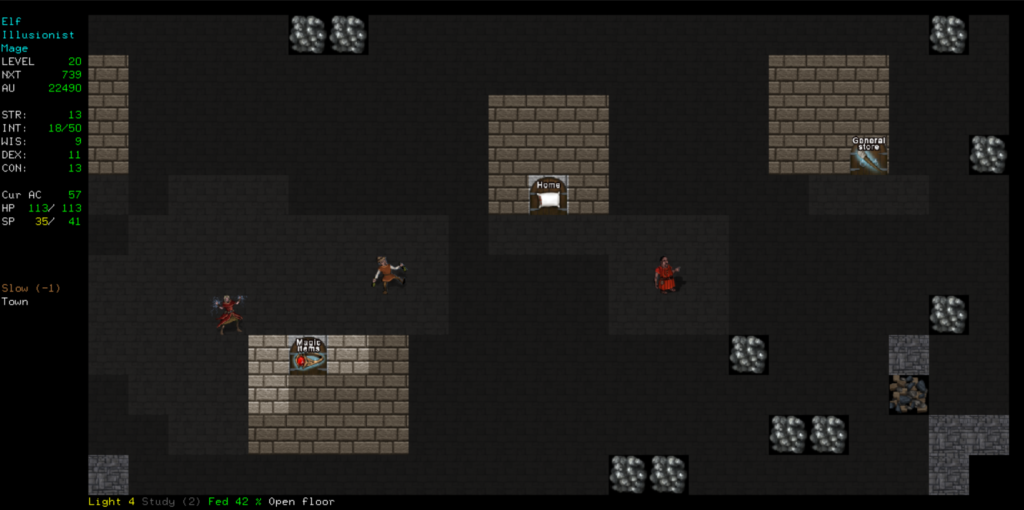
NetHack’s has a stronger sense of place than Angband, where dungeon levels are much larger but also less distinctive, and anyway are forgotten once you leave a level. If you go downstairs then right back upstairs in Angband, you’ll find a completely different map waiting for you, with new monsters and items. NetHack’s dungeons persist so long as your character survives, and you can go back to a level after a long time and find it’s largely as you left it.
It’s possible to see a kind of rivalry between NetHack and Angband, but I think this is largely an illusion. Both games know what they’re about and are content to pursue it in their own way.
While NetHack has more name recognition, lots of people like Angband! It’s spawned several popular variants all its own. One of them, ZAngband, is basically its own game by now, with a ton of variants and other notable branch-offs.
The Legacy of Moria
While Beneath Apple Manor has many aspects of a roguelike, Rogue is still at the center of the roguelike genre. Rogue inspired Hack, and then, NetHack.
But also, Rogue inspired Moria, and in fact Moria predates Hack by several years. Moria may be the first “roguelike” game, in that it’s not Rogue itself but was clearly inspired by and derived from Rogue. Even the “direct” descendants of Rogue, like URogue and SuperRogue, came along after Moria. If there is another character-based game played on university computing terminals between Rogue’s release and Moria’s, word of it has not come down to me.
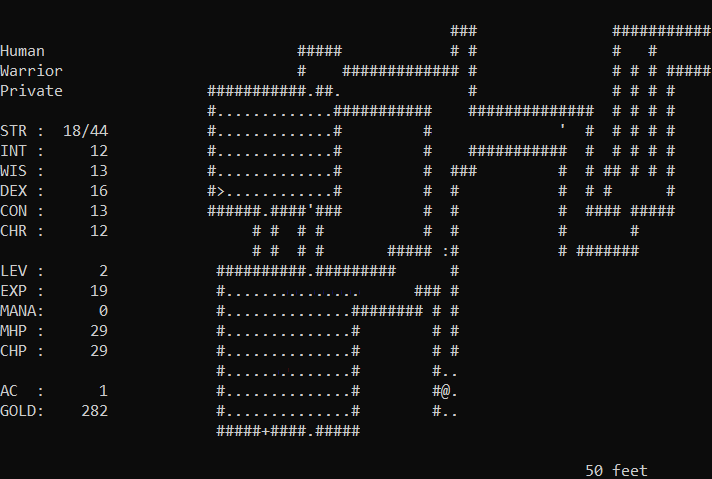
Moria was created by (the recently deceased) Richard Koeneke. First written in a dialect of BASIC, then converted to one of Pascal, he left university and, like many other roguelike authors who exited academia, appears never to have worked on their game again. But he opened the game’s source, and some other people ported it to C, and called the new version UMoria. UMoria still exists, and can be downloaded to play locally or via a web browser.
The significance of Moria and UMoria on the history of computer gaming cannot be overstated. Rogue was popular yes, and has inspired a legion of games taking one or more of its aspects and running with them. But there is something fundamental to the core of Moria that has seeped even more deeply into CRPGs. Diablo’s credits mention UMoria as a direct inspiration, but more than that, the basic sense of Moria has become pervasive.
It is easy to forget now that there used to be all freaking kinds of RPGs, and early on games in the genre looked very different from how they look today. dnd and Oublette on PLATO systems have a slightly familiar kind of overhead view, with the walls of the dungeon around you drawn in lines, but monsters don’t exist outside of your immediate interactions with them. Wizardry, what is now weirdly called a “blobber,” has a grid-based world that is experienced in first-person, and this became a very common means of presentation, inspiring… well, all of these are purely from memory: The Bard’s Tale series, the Might & Magic series, Dragon Wars, Dungeon Magic, Eye of the Beholder, Dungeon Hack, Swords & Serpents on the NES, the dungeons of Phantasty Star on the SMS, Arcana over on the SNES, a funky 3D version of the original Bomberman on MSX, and countless other games that presented the mazes without the monsters. Even Strong Bad has wrestled against one of the blobber ilk with his begloved hands. (“Who’s Strong Bad,” asks half of my audience. I know, I’m old.)
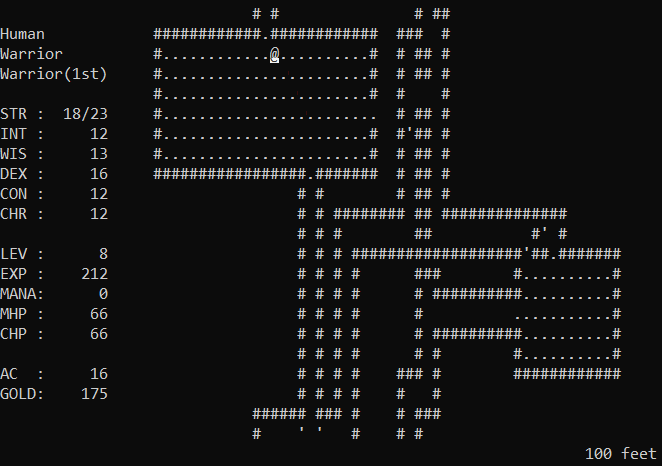
In particular, it should be remembered that Dungeons & Dragons, which inspired this whole category, was not a solo game. Despite promises of solitaire play in the 1st Edition AD&D DM’s Guide, you really needed at least two people, a player and a referee, or “DM,” to play; most groups had multiple players, each playing one or more characters. This is still how D&D is most commonly played today. Rogue was one of the games that, by attempting to offer a solo version of the experience, put the emphasis on the solo.
But Rogue has other things going on in it. Its identification game is a work of genius by itself, and the way its systems work together make it special in ways other than just being a D&D simulation. Its descendant Moria, on the other hand, offers a more generalized RPG framework, and that is what has come to suffuse and infect nearly the entire rest of video gaming. What Moria did was generalize the solo fantasy RPG experience. Moria has multiple attack types, like fire, cold, and electricity, and resistances to them, has equipment items with add-on special properties, and has a bunch of generally plain monsters but with colors that identify their properties like they were palette-swapped.
In fact, I do not think I am being hyperbolic when I say that, due to Moria’s influence on Diablo, nearly every game now that features what they call a “loot system,” is actually offering a Moria-style loot system. It is that pervasive. And Angband, as UMoria’s direct descendant, has kept up that system and elaborated upon it for over 30 years now.
J.R.R. Tokens
Angband started out as mostly a themed version of UMoria. If the name Moria sounds familiar, like you might have heard it in a movie once, that’s because it comes right out of Tolkien. The Mines of Moria* are the dungeons of the game, and that’s why at level 50 the player fights a Balrog, trying to do a better job of it than Gandalf did.
* Off the subject. A fun game to play if you’re of a frame of mind is, when watching the relevant scenes in the movie of The Fellowship of the Ring, to refer to random things as “the Something… of Moria!” You can start from outside with “The Gates of Moria!” Say it like Gimli, with a gruff voice, and it helps if you can rouse yourself to try a Scottish accent. It’s more entertaining if it’s a bad one. Then: The Halls… of Moria! The Goblins… of Moria! The Hasty Retreat… of Moria! The Panicked Screaming… of Moria! I find that one can amuse themselves for quite some time this way.
Well you might have heard that there are other Middle Earth books than The Hobbit and the Lord of the Rings trilogy. One of these, cobbled together by John Ronald Reuel’s son Christopher Tolkien, is The Silmarillion. It’s a big collection of backstories and myths and legends of questionable canonicity.
You might remember that the Mines of Moria were not the final destination of the LotR books, but merely a stop along the way. If you read The Silmarillion, you’ll know that there were once even worse places in Middle Earth than that. One of them was a stronghold of Morgoth, called the pits of Angband.
That’s why you fight Morgoth in the game of Angband, on level 100, and his lieutenant Sauron, the same entity that was the big baddie in The Lord of the Rings, on Level 99. And what’s more, all of Angband is deeply drenched in token Tolkienness. It’s got a bunch of Tolkien monsters, both unique types, from the afore-mentioned end bosses down to Farmer Maggot and his dogs, to representatives of species like goblins, orcs, Ainur, and Maiar. A lot of the items have add-on properties like being a weapon “of Westernesse,” which in game terms means it’s quite good.
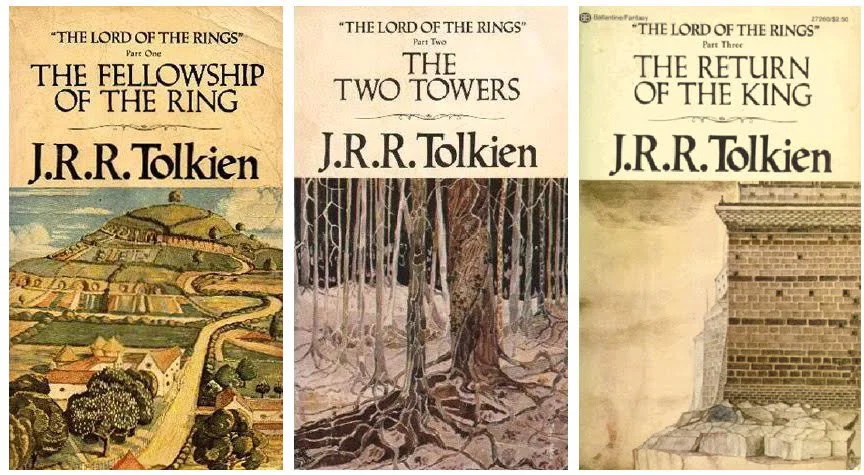
These were scavenged off of Reddit.
Despite how deeply it plumbs the pits, If you approach it as a full adventure in Middle Earth where you can visit the Shire, smoke a pipe with Frodo and hang out with Strider, Angband will disappoint you. It takes the wonder and beauty of The Hobbit, the Lord of the Rings series, and the Silmarillion, and uses them as basically a list of monsters and items. Some of the variants that I’ll get to later try to restore a bit of that, but for the most part Angband is a game of tactical combat, map exploration, and loot collection, and anything from the literature that doesn’t fit that purpose is left out. There’s no Land of Mordor, Where the Shadows Lie; no Gondor with its rich history, except where it involves special monsters and items; and no sad departure of the Elves to the West. (Writing about Tolkien involves capitalizing a lot of seemingly random terms.)
It’s not that Angband seeks to balderize Tolkien, but that it just has no place to use those aspects of his work. These are generic fantasy exploration and tactics games that have been given a coat of Tolkien Paint, probably by Tom Bombadil, who has had difficulty finding work lately.

Painting by the Brothers Hildebrandt, borrowed from this page.
What Angband gets from the Lord of the Rings and its subsidiary books is a rich lore that it can just do with as it pleases. It lends weight to the games. Instead of just making up a bunch of monsters, which often falls flat, it puts on an Elven Cloak and seems richer for it. It’s not just Angband itself; there’s a whole family of Angband variants that work by replacing (or sometimes, just supplementing) the Tolkien stuff with material from some other author, from Roger Zelazny to Anne McCaffery to H.P.Lovecraft to Terry Pratchett.
That makes a good enough introduction! Next time, in a week, we’ll offer some early playing advice, then maybe a timeline of Angband and its versions, and after that will come the Herculean task of looking at some of those many variants. See you soon-adillo!

One thought on “@Play: A Reintroduction to Angband”
Comments are closed.